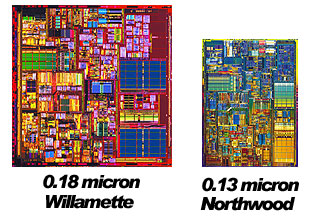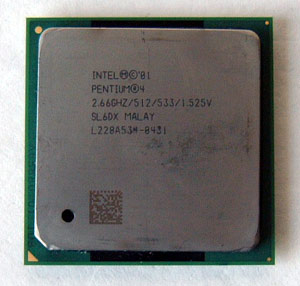Intel Pentium 4 2.66GHz Processor Review
 For those of us who want top of the line performance but don't want to
spend a fortune, the Pentium 4 2.66 GHz processor offers a good mix of power
and value. With a street price of $650 CDN ($300 US) the P4 2.66 is certainly
more expensive than a comparable AMD Athlon XP, but it's still quite a bit less
then the $830 CDN ($410 US) a P4 2.8 GHz commands. For those of us who want top of the line performance but don't want to
spend a fortune, the Pentium 4 2.66 GHz processor offers a good mix of power
and value. With a street price of $650 CDN ($300 US) the P4 2.66 is certainly
more expensive than a comparable AMD Athlon XP, but it's still quite a bit less
then the $830 CDN ($410 US) a P4 2.8 GHz commands.
I highly doubt
you'll notice the 140 MHz speed difference, but the $180 price difference will
be immediately evident!
 The P4 2.66 GHz processor runs on a 133 MHz (533 MHz) FSB, uses the same
familiar Socket m478 form factor and is based on the brand spanking new C1 stepping Northwood
core. The P4 2.66 GHz processor runs on a 133 MHz (533 MHz) FSB, uses the same
familiar Socket m478 form factor and is based on the brand spanking new C1 stepping Northwood
core.
The 2.66 GHz processor has all the technical goodies we
expect from a Pentium 4 processor including NetBurst Architecture, SSE2 and
Advanced Transfer Cache. It does not support Hyper-Threading however, that
speciality is reserved for 3.06GHz, and faster Pentium 4's.
Still, the Northwood core is no slouch, with 55 million transistors in the core it is a large chunk of silicon. The chip runs on a default voltage of 1.525V (0.025V higher
then B0 based Northwood's), and is based on the SL6DX revision. If you're
interested in learning more about Pentium 4 technology, please read our Pentium 4 1.5 GHz and if you're interested in hearing
about the Northwood P4 core, check out out P4 1.6A
review.
The Northwood
core has a great reputation for its overclockability, even
going so far as to pull back many enthusiasts from the loving clutches of AMD. Based on the C1
core, this chip was facing some pretty high hopes; beginning first with a slow and steady increase
in FSB values. Armed with a new Vantec 470W power supply I was confident I
wouldn't be limited by the PSU as was the case with a 300 Antec power supply and
a certain 2.8GHz Pentium 4 processor.
Sights were set on 145MHz, then 150MHz, and even 155 MHz FSB
with no apparent problems. We did have to change the memory divider on the Albatron PX845E Pro from
3/4 to 1/1 to keep things going smoothly.
At 160 MHz FSB we had to up the CPU core voltage to
1.6V to stabilize things. At 164 MHz we hit a weird wall, no matter how high the CPU Vcore
(even up to 1.85V!) was turned up, the 2.66GHz chip just wouldn't take it. Perhaps we need
something better then air cooling to hit those high FSB's? In the end, the
chip was pushed up to a very respectable 3.26 GHz on air cooling, with a voltage of
1.65V.
| pcstats
test system specs: |
|
|
computer hardware:
|
|
| processor: |
AthlonXP 2700+
Pentium 4 2.66 GHz
Pentium 4 2.8
GHz
Pentium 4 2.4 GHz |
| Clock
Speed: |
13 x 166 MHz = 2.16 GHz (XP 2700+)
18 x 133 MHz = 2.4
GHz (P4)
21 x 133 MHz = 2.8 GHz (P4)
20 x 133 MHz = 2.66 GHz
(P4)
20 x 163 MHz = 3.26 GHz |
| Motherboards: |
Albatron PX845E Pro*
Epox 8K3A+ |
| Chipset: |
Intel i845E
VIA KT333CE |
| Videocard: |
ATi Radeon 9700 Pro |
| Memory: |
256MB Corsair XMS3200 CAS2 |
| Hard
Drive: |
40GB Samsung SP4004H |
| CDROM: |
NEC 52x CD-ROM |
| Floppy: |
Panasonic 1.44MB Floppy Drive |
| Heatsink: |
AVC Sunflower
Thermalright SK-6 w/40
CFM YS Tech |
| PowerSupply: |
Antec 300W PSU |
| Software
Setup |
WindowsXP Build 2600
Intel INF
4.00
VIA 4in1 4.43V
ATi Catalyst 2.3 |
| Benchmarks |
SysMark 2002
Business Winstone 2002
Content Creation
2002
Super Pi
POVray
SiSoft Sandra 2002
Pro
3DMark2001 SE
Quake III
Arena |
* - The
Albatron PX845EPro enables a 3/4 memory divider by default at 133
MHz.
|

